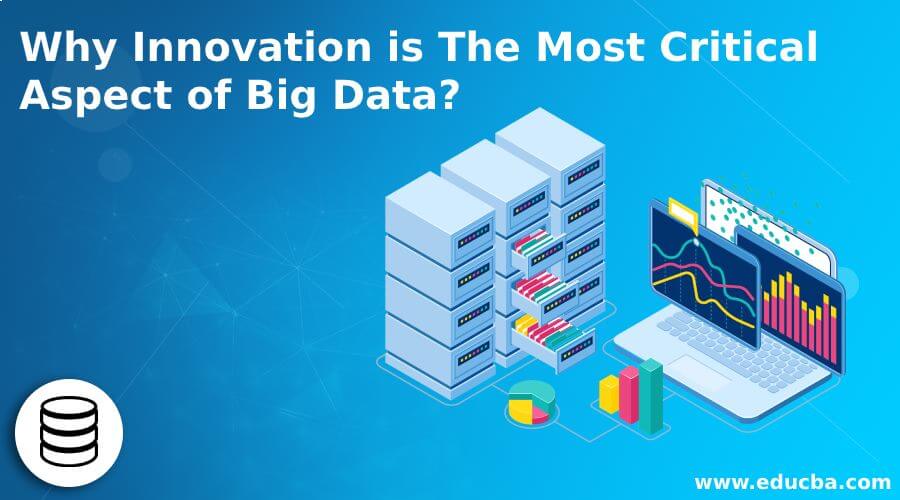Updated June 2, 2023
Introduction to Why Innovation is The Most Critical Aspect of Big Data?
Innovation and creativity have always played prime roles in helping brands and companies succeed in the short and long term. The need for creative problems has increased dramatically because the kinds and challenges that brand managers face are getting more complex and complicated daily. When brands are innovative in their approach to solving hurdles, then they, more often than not, can resolve their issues faster and easier manner.
Creativity is one of the most significant driving forces behind innovation because it allows individuals to challenge the existing situation and develop innovative, unique, and effective solutions. It will enable brands to break the shackles of normality, uniquely expand their brands, and set new rules and benchmarks within the industry.
Why is Creativity such a Critical Element in Organizations?
Innovation and creativity are the most essential elements in any organization and will result in gains and success. By embracing creativity and exploring new territories, brands can reach new levels of productivity and growth within a company. When brands encourage employees to think outside the box and allow them to explore their talents, companies can continue to grow and discover solutions to many of their internal and external conflicts. Therefore, creativity is a sure-shot way brands can solve their problems. So whether brands want to develop a new strategy, creative thinking will get them ahead. Creativity, without a doubt, sets organizations apart from others and gives them a competitive edge in all aspects of the operation.
Creative ideas and innovative approaches can help brands in all possible manners from the point of view of customers, target groups, employees, or partners. Bringing a unique perspective to their plans not just encourages communication but also brings a unique manner of functioning and management within the company. Some of how companies can develop a culture of innovation include the following:
Failing is a Part of the Learning Curve
Many brands are afraid to fail in any manner. This is because failure is considered a sign of weakness, and even when there is an opportunity, many companies hesitate to take a leap of faith. As against popular notion, successful brands have often failed several times before eventually achieving success in the true sense. Further, failure is also a form of freedom. This is because now the worst has happened. While failure on a large scale can be avoided, it is essential to face failure strategically.
As J.K. Rowling says, There is no way to live life without failing occasionally. You won’t fail only if you live so guardedly that you barely live, wherein you fail by default. Overcoming failure is possible when brand managers accept, annoy, dissect, and learn from it. As they say, failure is the stepping stone to success and growth. The bottom line is that brands must learn from their failure and, even if there are obstacles, remain positive, as a good attitude can go a long way in helping brands gain the success they wish to achieve eventually.
Brand Managers must Learn to Lead from the Front, In all Situations
Running a big brand or company is no easy task, as it requires constant attention and hard work. So while there may be many highs and successes, management will also face many lows and challenges. Often, a brand is successful because of the efforts and hard work of the entire team rather than just a single individual. A brand manager, therefore, needs to act in a manner that will enable them to distribute the required tasks according to the capabilities and talents of the employees.
Another thing that brand managers must learn to do is learn from past experiences. Share stories about your campaigns so that you learn about what went right and what went wrong. Good communication between team members and employees will keep the team motivated, encouraged, and keen to perform despite all obstacles. In short, bring everyone together so that everyone participates in the success story of the brand/company.
Always Remember to Reward Innovation and Incentives at Every Stage
Every employee likes to feel appreciated and understood. That is why brand managers must always appreciate the effort and hard work of their employees and appreciate their effort. Always create a method to recognize and reward team members for their efforts. Not all the rewards the employee gives have to be financial; they can also be rewarded in many other ways. These include incentives and other professional development courses, among other things. With continued dedication and effort, employees can integrate innovation into their professional tasks and effectively face challenges in this manner.
Innovation is, therefore, the basis of success for brands and companies across sectors. Additionally, when companies are responsive and resilient, they have all the ingredients to stay ahead of their competition successfully. This is where big data analytics can help companies strategically achieve goals. By analyzing the information, brands can deal with change effectively. By gathering data on various aspects of the organization and making required changes, brands can move ahead on the path of progress in a much more successful fashion.
This has always been the goal of brand managers who want to take their companies ahead on the path of development, profitability, and progress. Data analytics that helps support decision-making is, therefore, an essential element in any company, though it has one flaw is that it still involves human intervention and interaction. As Big Data gets bigger and bigger, the human element cannot be ignored. Still, the fact remains that human beings have a limited span of attention, especially when it comes to processing vast amounts of data.
Unless and until brands can make sense of the vast amounts of data available, techniques and methods of Big Data are redundant. That is why professionals who can help companies to use Big Data properly are in prime demand across companies and sectors. It is these people who can help companies use the insight that Big Data has generated so that it can be used to create campaigns that not just help brands reach their goals and objectives but also empower and strengthen brand power among their customers as well.
As humans lack attention, removing the human element is the only way to make Big Data seamless. This is to say that the entire big data process has to become completely automated. So if a business deals with equipment, everything from manufacturing to delivery is done through machines. Machines will fix these hurdles despite errors, making human interaction minimum and needed only in extreme situations.
Being more responsive to the needs of the brand needs is an essential requirement if brands are to stay in business, especially with rising competition and increasing consumer demands on the other hand. There are many areas in that brands can optimize their data in real time. These include optimizing salaries based on profit outcomes and corresponding security policies that align with the risk of loss. Brands can make automated and data-driven decisions by continually updating the company’s data.
Innovation is, therefore, the singular most important thing that can impact the growth and development of Big Data on the one hand and its advancement on the other. By investing in big data, not just brands but economies and politics stand to be benefited in many ways. By investing in Big data, economies in Europe, including government administrators, can save more than a hundred billion euros in operational efficiency by reducing fraud and boosting revenues and taxes. By saving money and ensuring better efficiencies, governments can create better results while saving money and effort. Here are some reasons why innovation is integral to big data and analytics.
- Data is an essential part of almost every sector around the globe. It has become an integral part of how brands and companies function. It is as important as capital and labor in today’s economy. As the amount of data increases daily, it is estimated that 5 quintillion bytes of data are generated every minute, which is set to increase daily. By making sense of this vast data, companies can expand and grow in many ways that would have seemed impossible until yesterday. The rate of expansion and growth has grown tremendously after the introduction of Big Data, and add to that the angle of innovation, companies can quickly gain a competitive edge. Investing in innovative big data technology is how brands can increase and improve profitability in the coming years.
- Big data can be used to create value in five distinct ways. The first way is to ensure that data is transparent in all manners. By providing that data is transparent throughout the organization, it becomes possible for brand managers to gain insights from them simply and effectively. Data transparency is essential; this is the first step towards creating value through big data.
The second way to generate value in big data is to create and store transactional data in the digital medium. By storing information in this manner, brand managers can collect accurate and detailed information; this, in turn, helps them optimize details for many things, including product inventories to employees’ sick days. By doing this, companies can keep a tab on all the company’s functioning and, in the process, boost their performance and use existing opportunities. Through the use of Big data, companies are successful in making better decisions and managing their inventories in a better manner. By adjusting their goals and objectives to align with the big data objectives, brands can successfully empower and strengthen their brand image.
The third way big data can add value to a company is by helping them personalize their products and services according to their target audience. Personalization of products is essential in this competitive age, so it is important to tailor products and services to their needs. Every customer loves having a personal touch when buying products and services. Always remember that an engaged and loyal customer is one of the most significant assets of any company. Developing ingenious engagement methods is the need of the hour for all brands and companies that want to succeed. The bottom line is that the personalization of services will help brands retain their existing customer base and expand it profitably.
The fourth and final way big data can help companies is by assisting them to make better decisions. It can help them provide not just practical and superior services but also enhance after-sales support as well. For instance, with Big data, manufacturers can embed their products with sensors to understand customer needs and provide better after-sales service offerings, helping them stand out.
- Big data is the future for all companies and brands. It will be the basis on which companies grow and innovate, as it is the next big thing. Just from the point of view of competition, big data has the potential to take companies to the next stage of growth. According to Gartner analyst Svetlana Sicular,
“Convergence of social, mobile, cloud and big data technologies presents new requirements – getting the right information to the consumer quickly, ensuring reliability of external data you don’t have control over, validating the relationships among data elements, looking for data synergies and gaps, creating provenance of the data you provide to others, spotting skewed and biased data.”
As technology develops, brands will need new methods to keep up with this rapid change to remain viable and effective. In short, brands can stay ahead of the competitive curve by effectively combining powerful analytics with the correct data. So the earlier they start down this road, the more chances they have for learning and using this medium effectively.
- When coupled with innovation, big data can help bring a new era of productivity and consumer growth. Many studies have proven that investing in good analytical techniques can help brands to increase their operating gains by more than 60 percent. By offering numerous benefits to consumers and companies, innovation and big data are here to stay long. In addition, with a host of personal location devices that are gaining a lot of prominence, big data can open a host of opportunities for brands to connect and engage with clients personally and intimately.
In summary, achieving success in a competitive environment is challenging. But at the same time, it is incredibly fulfilling and satisfying. And one way a company can continue on the path of success is by investing in techniques and innovation that will help them strengthen their internal communication and external relationships with clients, customers, and stakeholders.
Recommended Articles
This has been a guide to Why Innovation is The Most Critical Aspect of Big Data. Here we have discussed a brief overview of why is creativity such a critical element in organizations? and failing is a part of the learning curve. You may also have a look at the following articles to learn more –








